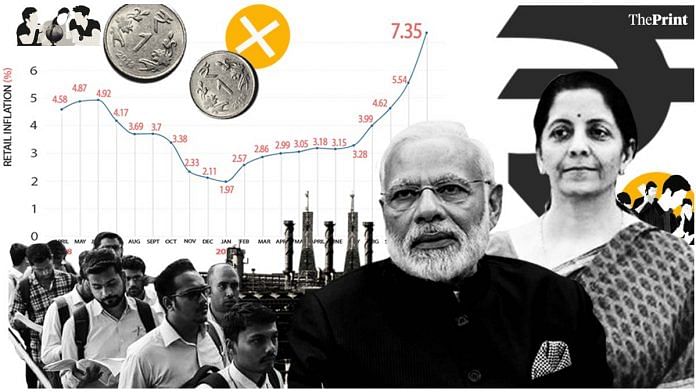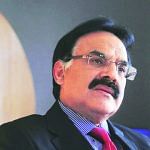
Former PM Manmohan Singh had warned in November 2019 that the Indian economy was entering a stage of stagflation, with high inflation and stagnant demand. Retail inflation for December 2019 increased to 7.35 per cent, highest since July 2014, going past the RBI’s limit of 6 per cent. In FY20, India’s GDP growth is pegged to be at 5 per cent.
ThePrint asks: Inflation at 7.3% and growth at 5% — is Indian economy facing stagflation?
Policymakers have missed out on the fact that private investors shy away from locations of social unrest
 Arvind Mayaram
Arvind Mayaram
Former Finance Secretary
We are on the cusp of a recession. There is evidence of stagnation in terms of growth numbers, industrial output, and core infrastructure. Demand is flat and green shoots are not evident in private investment. Then again, growth numbers are only estimates. Real numbers will be out in May and I suspect we won’t even touch 5 per cent GDP growth.
The situation that led us here is peculiar. As demand flattened, there was no incentive for greenfield investment or expansion in existing capacities. Therefore, there was no incentive to produce more. Whether the current spike in inflation will correct itself fully or marginally in the next two quarters remains to be seen. The public distribution system (PDS) has also seen no reforms.
Two factors are important. First, the Modi government spending on infrastructure won’t be felt by the masses across India. Unless farmers and landless labourers get surplus money in their hands, rural consumption won’t improve. We have seen that happen: even after sacrificing Rs 1.45 lakh crore corporate tax needle didn’t move an inch in terms of private investment or consumption. Second, private investment continues to be shackled. Enforcement agencies need to take the foot off the peddle when it comes to taking action against economic players because the fear stifles the “animal spirit” of investors.
Policymakers have missed out on the fact that private investment shies away from locations witnessing social unrest. The Narendra Modi government must realise that unpredictable policies can create uncertainty in the minds of investors.
Not manufacture or agriculture, it’s time to acknowledge that India will be a services-driven economy
 Nirupama Soundararajan
Nirupama Soundararajan
Senior Fellow & Head of Research, Pahle India Foundation
It is reasonable to assume that India is on the precipice of stagflation. The reason for inflation clearly seems to be a contraction in the aggregate supply of goods and services. Customary counter inflationary measures such as increasing interest rates will not work since the cost of capital is already high.
This means the focus must be turned towards increasing growth and increasing the output of goods and services. It is time for India to rethink its development plan. For far too long, we have dreamed of the manufacturing sector pushing us up the growth trajectory. We have had similar dreams about the agriculture sector. It is time for us to acknowledge that India will be a services-driven economy, and why not – with a billion people, it should be an obvious choice.
India must look at new sectors to fuel growth. While we ensure that growth in manufacturing and agriculture do not slump dramatically, we must look at economic and fiscal stimulus into sectors such as food and hospitality and tourism. We must focus on retail and e-commerce. It is time for India to step away from customary engines of growth and turn to new avenues at the earliest, to thwart stagflation.
Current inflation is largely food inflation-driven where monetary policy has little role
 Himanshu
Himanshu
Associate professor of Economics, JNU
The numbers clearly suggest that we are currently in stagflation or moving towards it. Food inflation is responsible for the spike in inflation and while there is an element of seasonality to it, given that the data is year-on-year, it is not the only factor. Cereal inflation is most worrying because it is a result of the Narendra Modi government sitting on high stocks and creating artificial scarcity in markets. Inflation in pulses is driven by low supply but also other factors. That said, the next 3-4 months will be a ‘wait and watch’ scenario to see if inflation reaches moderate levels. Monetary measures will not adequately solve the problem because the current inflation is largely food inflation-driven where monetary policy has little role.
Demand has dropped drastically at the same time. The Modi government will have to focus on boosting consumption even if it means at the cost of fiscal prudence. The ongoing stagflation should not deter the government from taking up expansionary policies in the upcoming Budget. Reviving rural demand should be the priority. The government is yet to recognise that there is a serious demand problem.
It is also important to note that while the numbers do point to stagflation, the phenomenon is not purely empirical. Financial markets and other factors also play a role. It is a deeper crisis than what is being projected.
Not strictly a stagflation because there isn’t a spillover from food to non-food inflation
 Radhika Pandey
Radhika Pandey
Fellow, National Institute of Public Finance and Policy (NIPFP)
The spike in inflation has been driven mainly by seasonal food inflation which is likely to cool down by February. October to February is typically the period where there is the pressure of food prices and the RBI is mandated to target headline inflation, which includes food. I suspect the month of January will see another round of high inflation but once again, it will only be due to an upsurge in two or three vegetable prices — onion, potato and garlic. If you remove these three from the equation, inflation is really less than 5 per cent.
Also, core inflation continues to be subdued reflecting weak demand. We don’t see much spillover from food to non-food inflation. Therefore, we are not strictly facing stagflation.
The Narendra Modi government shouldn’t be too concerned about headline inflation and should continue with a sustainable expansionary fiscal policy for the Budget. The focus should be on counter-cyclical policy, with measures aimed at giving an impetus to growth through tax cuts and infrastructure spending.
While I don’t see economic revival in this year, there is significant ‘bottoming out’ that is already taking place. For example, the uptick in index of industrial production and Purchasing Managers’ Index (PMI). The worst might be over but a long-drawn revival process awaits. The impact of RBI’s 135 basis points rate cut and the government’s initiatives to pump prime the economy will show some impact in the next 6-8 months.
Views are personal.
Also read: Can India handle frequent onion crisis without fixing its distortionary farm economics?
By Pia Krishnankutty, journalist at ThePrint

The misery index is an economic indicator, created by economist Arthur Okun. The index helps determine how the average citizen is doing economically and it is calculated by adding the seasonally adjusted unemployment rate to the annual inflation rate. It is assumed that both a higher rate of unemployment and a worsening of inflation create economic and social costs for a country.
No country in the world has become a developed economy with service sector. Kiss maufacturing due to inompetence and you kiss development.
Indian economy is staganant position, no policy looks better to handle it. To distract the nation from socioeconomic unrest the two persons PM & AS trying with emotional factors CAA/NRC. No one from the government side ready to accept the fact & coming forward with solutions,this more serious. Try to fool the the common men they are showing their knowledge
No matter if the inflation is driven by food prices- pulses and vegetables and is perceived as a temporary phenomenon. It is food inflation that hurts poor and lower middle class the most. It is pertinent to note that ordinary people are not bothered about movements in economic indices, excepting one – the inflation. It is the inflation that decides election results and Modi knows it well. Suitable measures to contain the spiral are necessary.
Revival of private investment lies in the distant future. There is unused capacity, and private consumption is weak. Nor has the government’s capital expenditure on roads and rail provided any boost to the economy. The first priority should be to support households in boosting their spending. Austerity in the government, which has so far insulated itself – and its employees – from the slowdown that is scalping everyone else. 2. One hopes the predictions that the spike in inflation will soon reverse itself prove correct. For the average household, food and fuel are major items of expense, so the distinction between core and non core inflation is a little academic. It will look insensitive if the RBI cuts rates when inflation is almost 8%. 3. At such a difficult time for the economy, giving salience to issues that are divisive, undercut economic momentum can make us seem a little out of touch with reality.
Someone once asked Abraham Lincoln how he felt after losing a particular election. Well, he said, I am too old to cry, but it hurts too much to laugh.